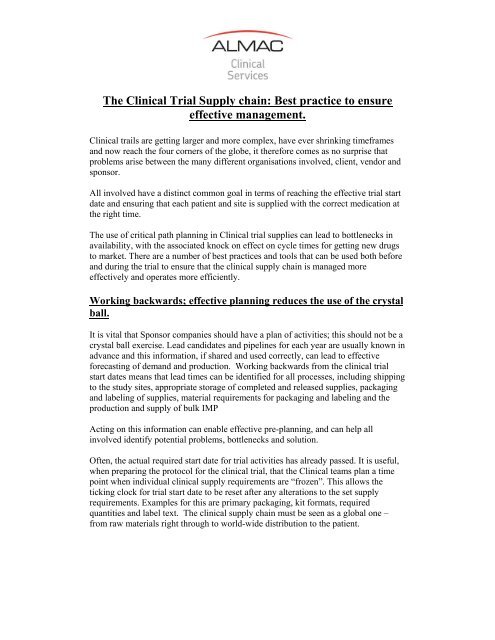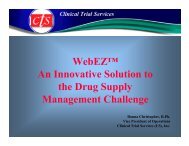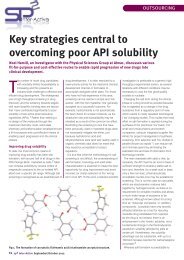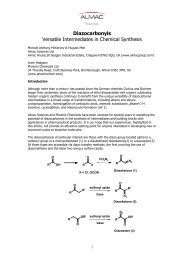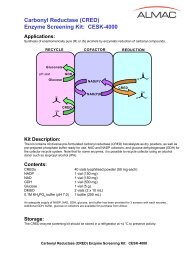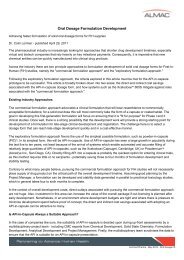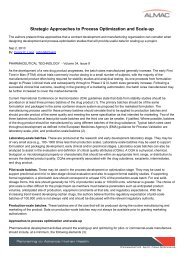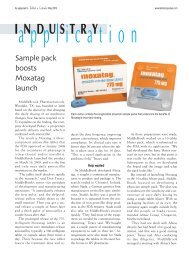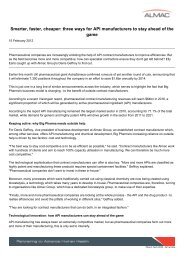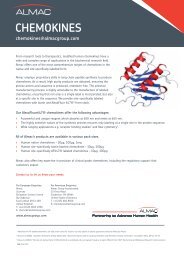The Clinical Trial Supply chain: Best practice to ensure ... - Almac
The Clinical Trial Supply chain: Best practice to ensure ... - Almac
The Clinical Trial Supply chain: Best practice to ensure ... - Almac
You also want an ePaper? Increase the reach of your titles
YUMPU automatically turns print PDFs into web optimized ePapers that Google loves.
<strong>The</strong> <strong>Clinical</strong> <strong>Trial</strong> <strong>Supply</strong> <strong>chain</strong>: <strong>Best</strong> <strong>practice</strong> <strong>to</strong> <strong>ensure</strong><br />
effective management.<br />
<strong>Clinical</strong> trails are getting larger and more complex, have ever shrinking timeframes<br />
and now reach the four corners of the globe, it therefore comes as no surprise that<br />
problems arise between the many different organisations involved, client, vendor and<br />
sponsor.<br />
All involved have a distinct common goal in terms of reaching the effective trial start<br />
date and ensuring that each patient and site is supplied with the correct medication at<br />
the right time.<br />
<strong>The</strong> use of critical path planning in <strong>Clinical</strong> trial supplies can lead <strong>to</strong> bottlenecks in<br />
availability, with the associated knock on effect on cycle times for getting new drugs<br />
<strong>to</strong> market. <strong>The</strong>re are a number of best <strong>practice</strong>s and <strong>to</strong>ols that can be used both before<br />
and during the trial <strong>to</strong> <strong>ensure</strong> that the clinical supply <strong>chain</strong> is managed more<br />
effectively and operates more efficiently.<br />
Working backwards; effective planning reduces the use of the crystal<br />
ball.<br />
It is vital that Sponsor companies should have a plan of activities; this should not be a<br />
crystal ball exercise. Lead candidates and pipelines for each year are usually known in<br />
advance and this information, if shared and used correctly, can lead <strong>to</strong> effective<br />
forecasting of demand and production. Working backwards from the clinical trial<br />
start dates means that lead times can be identified for all processes, including shipping<br />
<strong>to</strong> the study sites, appropriate s<strong>to</strong>rage of completed and released supplies, packaging<br />
and labeling of supplies, material requirements for packaging and labeling and the<br />
production and supply of bulk IMP<br />
Acting on this information can enable effective pre-planning, and can help all<br />
involved identify potential problems, bottlenecks and solution.<br />
Often, the actual required start date for trial activities has already passed. It is useful,<br />
when preparing the pro<strong>to</strong>col for the clinical trial, that the <strong>Clinical</strong> teams plan a time<br />
point when individual clinical supply requirements are “frozen”. This allows the<br />
ticking clock for trial start date <strong>to</strong> be reset after any alterations <strong>to</strong> the set supply<br />
requirements. Examples for this are primary packaging, kit formats, required<br />
quantities and label text. <strong>The</strong> clinical supply <strong>chain</strong> must be seen as a global one –<br />
from raw materials right through <strong>to</strong> world-wide distribution <strong>to</strong> the patient.
<strong>Clinical</strong> <strong>Supply</strong> Inven<strong>to</strong>ry Chain<br />
BULK IMP<br />
Packaging<br />
components<br />
Label text<br />
CENTRAL<br />
PACKAGED<br />
TRIAL SUPPLY<br />
STOCK<br />
Site inven<strong>to</strong>ry<br />
Depot inven<strong>to</strong>ry<br />
<strong>Trial</strong> FPI date<br />
Resupply – trial running<br />
Figure 1- Working back from expected First Patient In (FPI) Date<br />
When an overview of all scheduled trial supply requirements is agreed, the planning<br />
process can enter in<strong>to</strong> a more detailed phase noting each deliverable component<br />
required <strong>to</strong> produce the supplies for the study start date. Without going in<strong>to</strong> the<br />
mechanics of project management, the trial manager will of course balance CTA<br />
submissions and approvals, along with country specific requirements, in parallel with<br />
the production of the clinical trial supplies and its associated inven<strong>to</strong>ry <strong>chain</strong>.<br />
S<strong>to</strong>ck levels and tracking of clinical trial supplies<br />
Once the clinical trial supplies are available <strong>to</strong> start the trial, the tracking and<br />
moni<strong>to</strong>ring process can begin <strong>to</strong> <strong>ensure</strong> that s<strong>to</strong>ck levels of kits are maintained and<br />
that the supply <strong>to</strong> each patient is continuous and uninterrupted. Usually for later phase<br />
trials with large patient populations, supplies are delivered in phased campaigns, often<br />
due <strong>to</strong> expiry date limitations or compara<strong>to</strong>r availability. This in turn means that<br />
s<strong>to</strong>ck levels of the initial supply of kits become absolutely critical <strong>to</strong> continuous<br />
patient supply. Now we enter a crucial phase.<br />
After study initiation, moni<strong>to</strong>ring of clinical supply inven<strong>to</strong>ry throughout the supply<br />
<strong>chain</strong> is essential in order <strong>to</strong> moni<strong>to</strong>r study kit usage and available s<strong>to</strong>ck levels, <strong>ensure</strong><br />
the drug is always available for patients, minimise waste medication, alert sites in<br />
case of potential supply delays and comply with GMP/ GCP conditions .
Approaches <strong>to</strong> clinical trial supply management: tips for<br />
improvement<br />
Moni<strong>to</strong>r s<strong>to</strong>ck level data<br />
Once a trial starts and recruitment gets in<strong>to</strong> gear, supply s<strong>to</strong>ck levels can often start <strong>to</strong><br />
deplete at a different rate than expected. Add <strong>to</strong> this the needs of expiry date<br />
management and soon supplies can start <strong>to</strong> dwindle. It is essential that s<strong>to</strong>ck level data<br />
is moni<strong>to</strong>red throughout the entire supply <strong>chain</strong>, but due <strong>to</strong> multiple parties and<br />
systems involved this is not a straightforward process.<br />
Some large Sponsor companies have inven<strong>to</strong>ry and management systems capable of<br />
moni<strong>to</strong>ring various portions of the supply <strong>chain</strong>. When the decision has been made <strong>to</strong><br />
outsource portions of the supply <strong>chain</strong>, Sponsor companies can suddenly find a<br />
gaping hole in any materials management systems. In many cases, once shipped<br />
globally, supplies can disappear <strong>to</strong>tally from the Sponsor’s radar, therefore creating a<br />
reliance on unconnected reports from other systems (mostly 3rd party), which require<br />
manual manipulation of data <strong>to</strong> forecast future supply needs and manufacturing<br />
requirements.<br />
Meet with sponsor companies and vendors<br />
It is useful <strong>to</strong> note that as kit inven<strong>to</strong>ry is moni<strong>to</strong>red by whatever means selected by<br />
the <strong>Clinical</strong> Managers, plans must be included <strong>to</strong> make the information available <strong>to</strong><br />
each participant in the supply <strong>chain</strong>. This means that outsourcing partners need <strong>to</strong> be<br />
involved in relevant data exchanges that may affect the availability of additional<br />
supplies, and that this involvement occurs in a timely fashion. In our experience, joint<br />
meetings involving Sponsor companies and associated vendors prior <strong>to</strong> study<br />
commencement are invaluable. Such meetings can present a platform <strong>to</strong> examine<br />
interface exchanges and possible alternative approaches <strong>to</strong> the study design. Also, it is<br />
possible <strong>to</strong> have one vendor responsible for multiple areas of the supply <strong>chain</strong>,<br />
therefore enhancing control and reducing management concerns.<br />
<strong>Supply</strong> <strong>chain</strong> management<br />
A variety of different approaches are available for management of the supply <strong>chain</strong><br />
when the study goes live, but the <strong>Trial</strong> <strong>Supply</strong> Manager must link the inven<strong>to</strong>ry data<br />
back in<strong>to</strong> the complete <strong>chain</strong>. Examples of inven<strong>to</strong>ry management include:<br />
<strong>The</strong> manual approach<br />
Many Sponsor companies employ a manual approach <strong>to</strong> the supply <strong>chain</strong>. Generally<br />
this will mean pre-defining set amounts <strong>to</strong> ship <strong>to</strong> each site on activation and then<br />
another set amount for further supplies. This can result in reduced visibility of the<br />
inven<strong>to</strong>ry and provide difficulties if sites take on a different level of activity than<br />
predicted. Supplies are usually manufactured/ packaged with at least of 100%
overage, therefore adding <strong>to</strong> the trial cost and lead times for production. Study<br />
moni<strong>to</strong>rs can provide inven<strong>to</strong>ry verification but this approach can lead <strong>to</strong> a<br />
fragmented approach if multiple supply campaigns are required.<br />
Use of Interactive Voice Response Systems (IVRS)<br />
Traditionally both IVR, and similar web based systems have been the scope of large<br />
Phase III trials, with complex dosing and inven<strong>to</strong>ry requirements. However the<br />
quality of reporting <strong>to</strong>ols available and management of randomisation has encouraged<br />
increased use within the industry. An IVRS provides full visibility of released<br />
finished patient kits held in Sponsor, or third party depots, and also at the study sites.<br />
During study set up, it is usually decided <strong>to</strong> supply sites either by using defined s<strong>to</strong>ck<br />
levels that are resupplied based on various set trigger points, or by a just-in time<br />
delivery (for each patient visit) depending on the best fit for the study.<br />
Ultimately, this can assist the clinical trial supply <strong>chain</strong> in not only presenting alerts<br />
for low s<strong>to</strong>ck levels at sites, but also in country or central depots such as a contract<br />
packager/distribu<strong>to</strong>r. <strong>The</strong> ability <strong>to</strong> manage the supply <strong>chain</strong> at site, country depot and<br />
central depot allows the trial medication <strong>to</strong> be managed more effectively, and can<br />
assist in the overall supply <strong>chain</strong>. Again, lead times for all components (such as bulk<br />
drug) and production of supplied kits, means that careful moni<strong>to</strong>ring of this interface<br />
is required.<br />
It has already been possible by agreeing common data set pro<strong>to</strong>cols <strong>to</strong> permit data<br />
interchange between IVR and distribu<strong>to</strong>r systems <strong>to</strong> facilitate electronic ordering of<br />
patient supplies. Although not full integration, it does at least serve <strong>to</strong> enhance<br />
reporting, visibility and ordering efficiency, especially when integrated with bar<br />
coding of the clinical supplies. By utilising a vendor with both distribution and IVR<br />
expertise, the trial supply can be integrated with input on streamlining trial set up and<br />
management of drug inven<strong>to</strong>ry.<br />
Forecasting programs<br />
Programs are available that can simulate different trial supply scenarios and model the<br />
affect of using differing variables in terms of patient recruitment levels, the quantity<br />
of site shipments and multiple site supply strategies. In combination with IVR or in<br />
isolation, these can be effectively used upfront <strong>to</strong> help decide on actual site supply<br />
strategies. Forecasting can also be used <strong>to</strong> estimate how long quantities of supplies<br />
will last for. This can be particularly useful when the study has commenced and<br />
forecasts need <strong>to</strong> be made covering the entire supply <strong>chain</strong> for resupply of study kits.
Electronic Data Capture (EDC) systems in the supply <strong>chain</strong><br />
Although primarily for quality data collection, certain data sets within EDC systems<br />
can be used by distribu<strong>to</strong>rs <strong>to</strong> predict an efficient just-in time drug supply, again<br />
helping effective moni<strong>to</strong>ring of inven<strong>to</strong>ry and reduction in waste drug. By using<br />
patient enrolment information and also establishing specific dispensing visit<br />
timetables, inven<strong>to</strong>ry can be managed between a distribu<strong>to</strong>r and EDC system. In our<br />
experience, this approach can work well for trials with simple dispensation rules and<br />
minimum dosing scenarios.<br />
Future solutions<br />
Several companies involved in outsourcing have attempted successfully the process of<br />
data integration on specific parts of the supply <strong>chain</strong>. However the main issue remains<br />
that with so many differing in–house systems and services provided by third parties<br />
that solutions tend <strong>to</strong> be point <strong>to</strong> point. As a result Sponsor companies that use a suite<br />
of <strong>to</strong>ols <strong>to</strong> manage the clinical trial supply <strong>chain</strong> face multiple areas of data<br />
integration. Each of these requires programming, testing and validation for each<br />
source in the <strong>chain</strong>. Likewise, the vendors also will have this problem for each<br />
Sponsor Company they are involved with.<br />
Standardised data transfer?<br />
Organisations such as CDISC (www.cdisc.org) are working <strong>to</strong> establish guidelines for<br />
data transfer standards, which could provide a platform for future integrations. Also<br />
file transfer pro<strong>to</strong>cols, such as XML, offer enhanced possibilities for data transfer.<br />
Data portals that allow multiple sources <strong>to</strong> “speak” using an integration layer present<br />
an opportunity for au<strong>to</strong>mated data sharing between companies, therefore feeding data<br />
from site, depot and the manufacturing facility <strong>to</strong> allow tighter supply <strong>chain</strong><br />
integration.
INVENTORY<br />
SYSTEM<br />
VENDOR<br />
INVENTORY<br />
IVRS<br />
SITE/ DEPOT<br />
INVENTORY<br />
BULK<br />
DRUG<br />
MATERIALS<br />
STUDY KITS<br />
SUPPLY<br />
STRATEGIES<br />
STOCK LEVELS<br />
MATERIALS<br />
STUDY KITS<br />
Data integration layer<br />
Reports – au<strong>to</strong>mated supply management<br />
Figure 2- future data standardisation allowing au<strong>to</strong>mated supply <strong>chain</strong> integration<br />
More efficient and effective clinical trials?<br />
Sponsor companies can assist the clinical trial supply departments both within their<br />
own company and outsourcing partners, by planning ahead and giving some visibility<br />
<strong>to</strong> the drug development plans. This will assist in management of demand forecasting<br />
and capacity, and also identify potential problems in advance.<br />
Further use of technology <strong>to</strong> control and manage various parts of the clinical supply<br />
<strong>chain</strong> means that data integration needs will grow within the industry. Organisations<br />
will strive <strong>to</strong> focus not only on operational expertise, but also on the ability <strong>to</strong><br />
integrate in<strong>to</strong> set data standards that allow them <strong>to</strong> take their place in an integrated<br />
supply <strong>chain</strong>.<br />
Jonathan Calderwood<br />
Global Marketing Manager<br />
<strong>Almac</strong> <strong>Clinical</strong> Services, Craigavon, UK<br />
Tel: +4428 3836 2436 Fax: +4428 3836 3623<br />
E-mail: jonathan.calderwood@almacgroup.com


